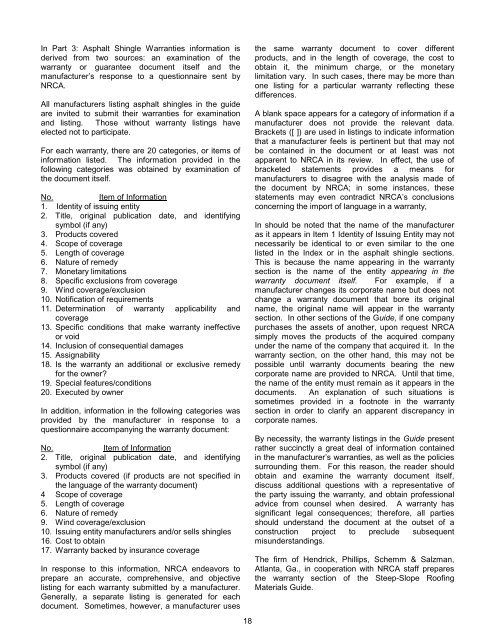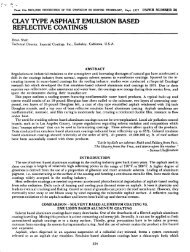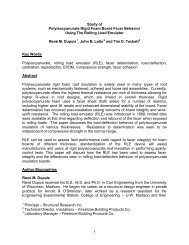2000 by the National Roofing Contractors Association. No
2000 by the National Roofing Contractors Association. No
2000 by the National Roofing Contractors Association. No
You also want an ePaper? Increase the reach of your titles
YUMPU automatically turns print PDFs into web optimized ePapers that Google loves.
In Part 3: Asphalt Shingle Warranties information is<br />
derived from two sources: an examination of <strong>the</strong><br />
warranty or guarantee document itself and <strong>the</strong><br />
manufacturer’s response to a questionnaire sent <strong>by</strong><br />
NRCA.<br />
All manufacturers listing asphalt shingles in <strong>the</strong> guide<br />
are invited to submit <strong>the</strong>ir warranties for examination<br />
and listing. Those without warranty listings have<br />
elected not to participate.<br />
For each warranty, <strong>the</strong>re are 20 categories, or items of<br />
information listed. The information provided in <strong>the</strong><br />
following categories was obtained <strong>by</strong> examination of<br />
<strong>the</strong> document itself.<br />
<strong>No</strong>. Item of Information<br />
1. Identity of issuing entity<br />
2. Title, original publication date, and identifying<br />
symbol (if any)<br />
3. Products covered<br />
4. Scope of coverage<br />
5. Length of coverage<br />
6. Nature of remedy<br />
7. Monetary limitations<br />
8. Specific exclusions from coverage<br />
9. Wind coverage/exclusion<br />
10. <strong>No</strong>tification of requirements<br />
11. Determination of warranty applicability and<br />
coverage<br />
13. Specific conditions that make warranty ineffective<br />
or void<br />
14. Inclusion of consequential damages<br />
15. Assignability<br />
18. Is <strong>the</strong> warranty an additional or exclusive remedy<br />
for <strong>the</strong> owner?<br />
19. Special features/conditions<br />
20. Executed <strong>by</strong> owner<br />
In addition, information in <strong>the</strong> following categories was<br />
provided <strong>by</strong> <strong>the</strong> manufacturer in response to a<br />
questionnaire accompanying <strong>the</strong> warranty document:<br />
<strong>No</strong>. Item of Information<br />
2. Title, original publication date, and identifying<br />
symbol (if any)<br />
3. Products covered (if products are not specified in<br />
<strong>the</strong> language of <strong>the</strong> warranty document)<br />
4 Scope of coverage<br />
5. Length of coverage<br />
6. Nature of remedy<br />
9. Wind coverage/exclusion<br />
10. Issuing entity manufacturers and/or sells shingles<br />
16. Cost to obtain<br />
17. Warranty backed <strong>by</strong> insurance coverage<br />
In response to this information, NRCA endeavors to<br />
prepare an accurate, comprehensive, and objective<br />
listing for each warranty submitted <strong>by</strong> a manufacturer.<br />
Generally, a separate listing is generated for each<br />
document. Sometimes, however, a manufacturer uses<br />
18<br />
<strong>the</strong> same warranty document to cover different<br />
products, and in <strong>the</strong> length of coverage, <strong>the</strong> cost to<br />
obtain it, <strong>the</strong> minimum charge, or <strong>the</strong> monetary<br />
limitation vary. In such cases, <strong>the</strong>re may be more than<br />
one listing for a particular warranty reflecting <strong>the</strong>se<br />
differences.<br />
A blank space appears for a category of information if a<br />
manufacturer does not provide <strong>the</strong> relevant data.<br />
Brackets ([ ]) are used in listings to indicate information<br />
that a manufacturer feels is pertinent but that may not<br />
be contained in <strong>the</strong> document or at least was not<br />
apparent to NRCA in its review. In effect, <strong>the</strong> use of<br />
bracketed statements provides a means for<br />
manufacturers to disagree with <strong>the</strong> analysis made of<br />
<strong>the</strong> document <strong>by</strong> NRCA; in some instances, <strong>the</strong>se<br />
statements may even contradict NRCA’s conclusions<br />
concerning <strong>the</strong> import of language in a warranty,<br />
In should be noted that <strong>the</strong> name of <strong>the</strong> manufacturer<br />
as it appears in Item 1 Identity of Issuing Entity may not<br />
necessarily be identical to or even similar to <strong>the</strong> one<br />
listed in <strong>the</strong> Index or in <strong>the</strong> asphalt shingle sections.<br />
This is because <strong>the</strong> name appearing in <strong>the</strong> warranty<br />
section is <strong>the</strong> name of <strong>the</strong> entity appearing in <strong>the</strong><br />
warranty document itself. For example, if a<br />
manufacturer changes its corporate name but does not<br />
change a warranty document that bore its original<br />
name, <strong>the</strong> original name will appear in <strong>the</strong> warranty<br />
section. In o<strong>the</strong>r sections of <strong>the</strong> Guide, if one company<br />
purchases <strong>the</strong> assets of ano<strong>the</strong>r, upon request NRCA<br />
simply moves <strong>the</strong> products of <strong>the</strong> acquired company<br />
under <strong>the</strong> name of <strong>the</strong> company that acquired it. In <strong>the</strong><br />
warranty section, on <strong>the</strong> o<strong>the</strong>r hand, this may not be<br />
possible until warranty documents bearing <strong>the</strong> new<br />
corporate name are provided to NRCA. Until that time,<br />
<strong>the</strong> name of <strong>the</strong> entity must remain as it appears in <strong>the</strong><br />
documents. An explanation of such situations is<br />
sometimes provided in a footnote in <strong>the</strong> warranty<br />
section in order to clarify an apparent discrepancy in<br />
corporate names.<br />
By necessity, <strong>the</strong> warranty listings in <strong>the</strong> Guide present<br />
ra<strong>the</strong>r succinctly a great deal of information contained<br />
in <strong>the</strong> manufacturer’s warranties, as well as <strong>the</strong> policies<br />
surrounding <strong>the</strong>m. For this reason, <strong>the</strong> reader should<br />
obtain and examine <strong>the</strong> warranty document itself,<br />
discuss additional questions with a representative of<br />
<strong>the</strong> party issuing <strong>the</strong> warranty, and obtain professional<br />
advice from counsel when desired. A warranty has<br />
significant legal consequences; <strong>the</strong>refore, all parties<br />
should understand <strong>the</strong> document at <strong>the</strong> outset of a<br />
construction project to preclude subsequent<br />
misunderstandings.<br />
The firm of Hendrick, Phillips, Schemm & Salzman,<br />
Atlanta, Ga., in cooperation with NRCA staff prepares<br />
<strong>the</strong> warranty section of <strong>the</strong> Steep-Slope <strong>Roofing</strong><br />
Materials Guide.





